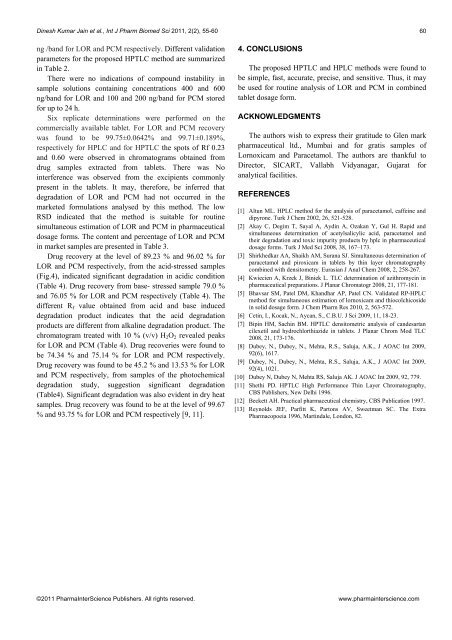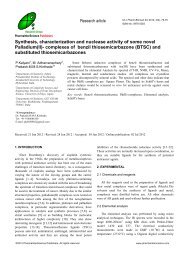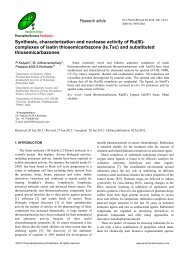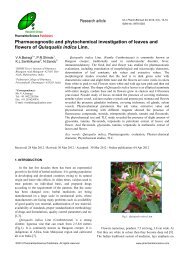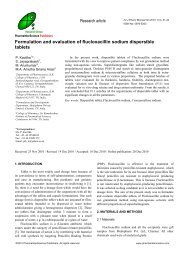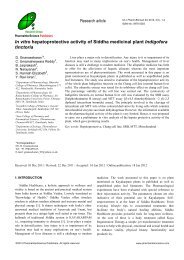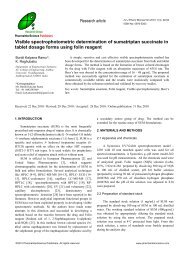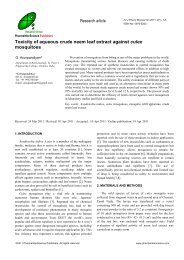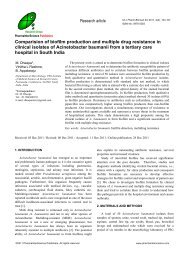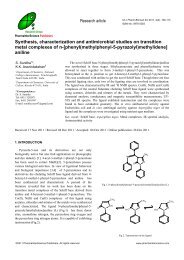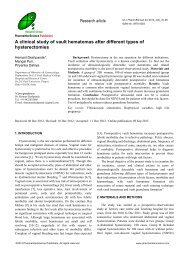Development and validation of a stability-indicating HPTLC method ...
Development and validation of a stability-indicating HPTLC method ...
Development and validation of a stability-indicating HPTLC method ...
You also want an ePaper? Increase the reach of your titles
YUMPU automatically turns print PDFs into web optimized ePapers that Google loves.
Dinesh Kumar Jain et al., Int J Pharm Biomed Sci 2011, 2(2), 55-60ng /b<strong>and</strong> for LOR <strong>and</strong> PCM respectively. Different <strong>validation</strong>parameters for the proposed <strong>HPTLC</strong> <strong>method</strong> are summarizedin Table 2.There were no indications <strong>of</strong> compound in<strong>stability</strong> insample solutions containing concentrations 400 <strong>and</strong> 600ng/b<strong>and</strong> for LOR <strong>and</strong> 100 <strong>and</strong> 200 ng/b<strong>and</strong> for PCM storedfor up to 24 h.Six replicate determinations were performed on thecommercially available tablet. For LOR <strong>and</strong> PCM recoverywas found to be 99.75±0.0642% <strong>and</strong> 99.71±0.189%,respectively for HPLC <strong>and</strong> for <strong>HPTLC</strong> the spots <strong>of</strong> Rf 0.23<strong>and</strong> 0.60 were observed in chromatograms obtained fromdrug samples extracted from tablets. There was Nointerference was observed from the excipients commonlypresent in the tablets. It may, therefore, be inferred thatdegradation <strong>of</strong> LOR <strong>and</strong> PCM had not occurred in themarketed formulations analysed by this <strong>method</strong>. The lowRSD indicated that the <strong>method</strong> is suitable for routinesimultaneous estimation <strong>of</strong> LOR <strong>and</strong> PCM in pharmaceuticaldosage forms. The content <strong>and</strong> percentage <strong>of</strong> LOR <strong>and</strong> PCMin market samples are presented in Table 3.Drug recovery at the level <strong>of</strong> 89.23 % <strong>and</strong> 96.02 % forLOR <strong>and</strong> PCM respectively, from the acid-stressed samples(Fig.4), indicated significant degradation in acidic condition(Table 4). Drug recovery from base- stressed sample 79.0 %<strong>and</strong> 76.05 % for LOR <strong>and</strong> PCM respectively (Table 4). Thedifferent R f value obtained from acid <strong>and</strong> base induceddegradation product indicates that the acid degradationproducts are different from alkaline degradation product. Thechromatogram treated with 10 % (v/v) H 2 O 2 revealed peaksfor LOR <strong>and</strong> PCM (Table 4). Drug recoveries were found tobe 74.34 % <strong>and</strong> 75.14 % for LOR <strong>and</strong> PCM respectively.Drug recovery was found to be 45.2 % <strong>and</strong> 13.53 % for LOR<strong>and</strong> PCM respectively, from samples <strong>of</strong> the photochemicaldegradation study, suggestion significant degradation(Table4). Significant degradation was also evident in dry heatsamples. Drug recovery was found to be at the level <strong>of</strong> 99.67% <strong>and</strong> 93.75 % for LOR <strong>and</strong> PCM respectively [9, 11].4. CONCLUSIONSThe proposed <strong>HPTLC</strong> <strong>and</strong> HPLC <strong>method</strong>s were found tobe simple, fast, accurate, precise, <strong>and</strong> sensitive. Thus, it maybe used for routine analysis <strong>of</strong> LOR <strong>and</strong> PCM in combinedtablet dosage form.ACKNOWLEDGMENTSThe authors wish to express their gratitude to Glen markpharmaceutical ltd., Mumbai <strong>and</strong> for gratis samples <strong>of</strong>Lornoxicam <strong>and</strong> Paracetamol. The authors are thankful toDirector, SICART, Vallabh Vidyanagar, Gujarat foranalytical facilities.REFERENCES[1] Altun ML. HPLC <strong>method</strong> for the analysis <strong>of</strong> paracetamol, caffeine <strong>and</strong>dipyrone. Turk J Chem 2002, 26, 521-528.[2] Akay C, Degim T, Sayal A, Aydin A, Ozakan Y, Gul H. Rapid <strong>and</strong>simultaneous determination <strong>of</strong> acetylsalicylic acid, paracetamol <strong>and</strong>their degradation <strong>and</strong> toxic impurity products by hplc in pharmaceuticaldosage forms. Turk J Med Sci 2008, 38, 167–173.[3] Shirkhedkar AA, Shaikh AM, Surana SJ. Simultaneous determination <strong>of</strong>paracetamol <strong>and</strong> piroxicam in tablets by thin layer chromatographycombined with densitometry. Eurasian J Anal Chem 2008, 2, 258-267.[4] Kwiecien A, Krzek J, Biniek L. TLC determination <strong>of</strong> azithromycin inpharmaceutical preparations. J Planar Chromatogr 2008, 21, 177-181.[5] Bhavsar SM, Patel DM, Kh<strong>and</strong>har AP, Patel CN. Validated RP-HPLC<strong>method</strong> for simultaneous estimation <strong>of</strong> lornoxicam <strong>and</strong> thiocolchicosidein solid dosage form. J Chem Pharm Res 2010, 2, 563-572.[6] Cetin, I., Kocak, N., Aycan, S., C.B.U. J Sci 2009, 11, 18-23.[7] Bipin HM, Sachin BM. <strong>HPTLC</strong> densitometric analysis <strong>of</strong> c<strong>and</strong>esartancilexetil <strong>and</strong> hydrochlorthiazide in tablets. J Planar Chrom Mod TLC2008, 21, 173-176.[8] Dubey, N., Dubey, N., Mehta, R.S., Saluja, A.K., J AOAC Int 2009,92(6), 1617.[9] Dubey, N., Dubey, N., Mehta, R.S., Saluja, A.K., J AOAC Int 2009,92(4), 1021.[10] Dubey N, Dubey N, Mehta RS, Saluja AK. J AOAC Int 2009, 92, 779.[11] Shethi PD. <strong>HPTLC</strong> High Performance Thin Layer Chromatography,CBS Publishers, New Delhi 1996.[12] Beckett AH. Practical pharmaceutical chemistry, CBS Publication 1997.[13] Reynolds JEF, Parfitt K, Partons AV, Sweetman SC. The ExtraPharmacopoeia 1996, Martindale, London, 82.60©2011 PharmaInterScience Publishers. All rights reserved. www.pharmainterscience.com


